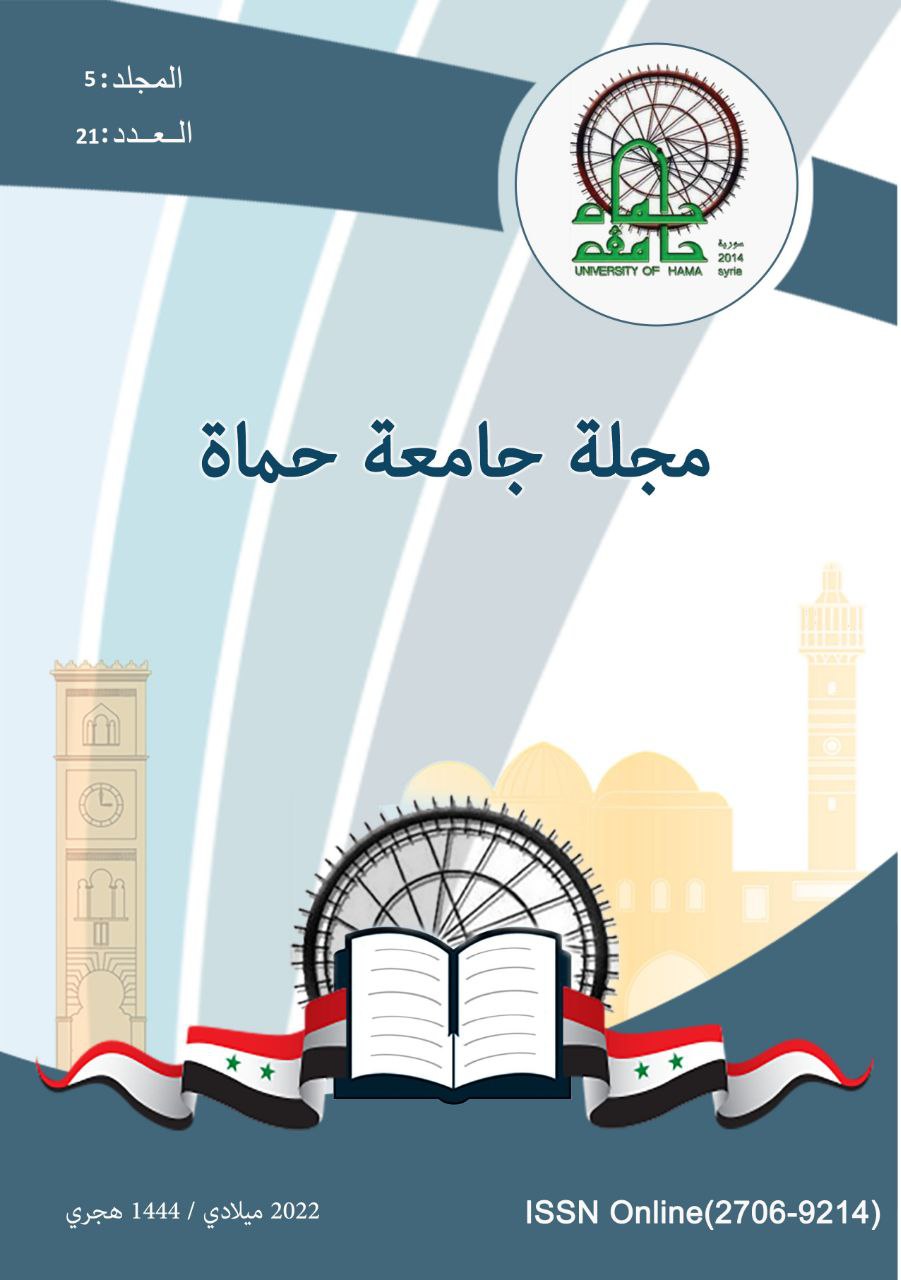The reality of the use of blended teaching methods from the point of view of secondary education teachers in the city of Lattakia
الملخص
The study aimed to know the reality of the use of blended learning methods in teaching from the point of view of secondary school teachers. Lattakia city, the study reached the following results:
The degree of responses of the study sample members of the teachers on the axis (attitudes towards the use of blended learning methods) ranked first, with a very high degree of approval, The axis (objectives of using blended learning aids) ranked second, with a high degree of approval, and the axis (obstacles to using blended learning aids) also came with a high degree of approval and ranked third, while the axis (blended learning aids used) ranked fourth, with a medium degree of approval. And the absence of statistically significant differences between the average degrees of the responses of the study sample members to the questionnaire about the reality of blended education in teaching from the teachers' point of view according to the variables (educational qualification, number of years of experience in teaching). And there are statistically significant differences between the average degrees of the responses of the study sample members to the questionnaire on the reality of blended learning in teaching from the teachers’ point of view according to the variable variable of training courses in the field of blended learning, “except for the obstacles to using blended learning methods” and these differences are in favor of teachers who follow one or more courses in The field of blended learning
References
1. إسماعيل، الغريب زاهر(2009).المقررات الإلكترونية تصميمها، إنتاجها، نشرها، تطبيقها، تقويمها. القاهرة: عالم الكتب.
2. حسن، إسماعيل محمد إسماعيل.(2010).برنامج إلكتروني لمقرر اللغة العربية لتنمية الفهم القرائي لدى طلاب المرحلة الثانوية في ضوء معايير الجودة للتعلم الإلكتروني. رسالة ماجستير غير منشورة، كلية التربية. جامعة القاهرة.
3. الخان، بدر.(2005) استراتيجيات التعلم الإلكتروني. ترجمة على الموسوي، وسام الوائلي، ومنى التيجي، حلب: شعاع للنشر والعلوم.
4. خميس، محمد عطية.(2003). منتوجات تكنولوجيا التعليم، القاهرة: دار الكلمة.
5. داوود, هديل سلمان.(2020). أثر استراتيجية التعليم المتمازج على الحس العلمي لطلاب الصف الثالث المتوسط لمادة علم الاحياء. مجلة الدراسات التربوية والعلمية, 2(15), 131-152
6. الشرمان, عاطف أبوحميد(2015).التعلم المتمازج والتعلم المعكوس. دار المسيرة للنشر والتوزيع: عمان.
7. الصنعاوي ,عبدالله بن فهد.(2018). واقع استخدام التعليم المتمازج في تدريس العلوم الشرعية بالمدارس القرآنية التابعة للمركز الخيري لتعليم القرآن الكريم وعلومه. مجلة كلية التربية-جامعة الإسكندرية, 28(5).
8. كنسارة، إحسان محمّد؛ وعطّار، عبد الله إسحاق.( 2011). الجودة الشاملة في التعليم الالكتروني. مكّة المكرّمة: مؤسسة بهادر للإعلام المتطوّر.
9. عبد العاطي، حسن الباتع، والمخيني، محمد راشد.(2010). أثر اختلاف نمطي التدريب)المتمازج- التقليدي( في تنمية بعض مهارات استخدام الحاسوب لدى معلمي مدارس التعليم الأساسي بسلطنة عمان. بحث مقدم إلى المؤتمر الدولي الأول لتقنيات التعليم العالي. مسقط، سلطنة عمان
10. غانم، حسن دياب علي2009). ).فاعلية التعلم الإلكتروني المختلط في إكساب مهارات تطوير برامج الوسائط المتعددة لطلاب تكنولوجيا التعليم بكلية التربية النوعية. رسالة دكتوراه غير منشورة.
11. قنديلجي, عامر ابراهيم.(2015). منهجية البحث العلمي,ط1, عمان، دار اليازوري العلمية للنشر و التوزيع
12. مرسي، وفاء حسن.(2008). التعليم المتمازج كصيغة تعليمية لتطوير التعليم الجامعي المصري: فلسفته ومتطلبات تطبيقه في ضوء خبرات بعض الدول. مجلة رابطة التربية الحديثة. مصر.
13. الجاسر, ندى محمد عبدالعزيز.(2018). واقع استخدام التعليم المتمازج لدى أعضاء هيئة التدريس بجامعة الأمير سطام بن عبدالعزيز. مجلة كلية التربية الأساسية للعلوم التربوية والإنسانية,(37), 101-116
المراجع باللغة الأجنبية:
1. Buket, A. & et al.,(2006), A Study on Students Views on Blended Learning Environment, Turkish on line Journal of Distance Education to JDE, July 7(3), p43-54.
2. Kitchenham, A.(2005)."Adult-Learning Principles, Technology and Elementary Teachers and their Students". the perfect blend.Education , Communication & Information. 3(5). pp285-302.
3. Maguire, K.(2005). Professional Development In Blended Learning Environment For Middle School Mathematics Teachers. M.A. dissertation. Canada: University of Toronto.
4. Motteram, g.(2006). Blended education and the transformation of teachers :Along- team case study in postgraduate UK higher education. Electronic Version. British journal of educational Technology. 17-30(1) 37.
5. Reiners, P., Renner, K., & Schreiber, J.(2005). The effect of technology integration on student motivation, engagement, and interest. Dakota State University.
6. Reason, CK & Stavkin, M.(2005). Questioning the Hybrid Model: student outcomes in different courses formats. JALN, 9(1), 83-94. Retrieved.3/4/2014 from:http://webshare.northseattle.edu/elearning/blended_learning/v91
7. Rovai, A., & Jordan, M.(2004). Blended learning and sense of community: A comparative analysis with traditional and fully online graduate courses. The International Review of Research in Open and Distance Learning, 5(2)from: http:// www.irrodl.org/index.php/irrodl/article/view/192/274
8. Singh, H.(2003). Building effective blended learning programs. Educational Technology, 43(6), 51–54.


